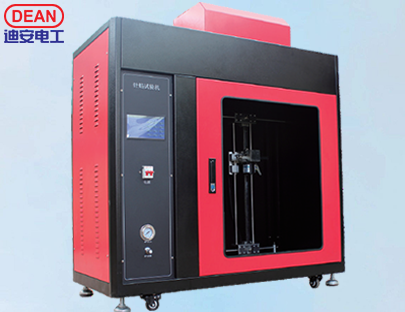Needle flame combustion tester
The touch screen control needle flame combustion testing machine is developed according to the requirements of standard gb4706.1-2005 and GB5169.5 "test flame needle flame test method device, confirmation test method and rules" on needle flame combustion test, and fully meets the national standards and the relevant UL, IEC standards of the new comprehensive equipment.In addition to the originality of the device itself with large functions, the device adopts full-color seven-inch touch operation display screen, which makes the test easy and efficient.At the same time, the horizontal and vertical movement of the style clip is controlled by the motor, which can move up and down automatically.
In this experiment, the fire risk was evaluated by simulating the effect of small flame caused by fault conditions.For other similar products in the market, it is necessary to start recording time with the left hand and pull the Bunsen lamp to the position where the sample is placed with the right hand at the beginning of the test. When the visual recording time is up, pull the Bunsen lamp back with the hand immediately.This instrument is designed to avoid uncoordinated misoperation by the user as much as possible. When the test starts, press "start" on the touch screen and the Bunsen lamp will automatically move right to the position of the sample. At the same time, the time relay will time, and the Bunsen lamp will automatically return to the starting position.
Product features
1. Programmable controller touch screen +PLC control, realizing multi-function of control/detection/calculation/data display
2. High degree of automation: automatic recording of test time, automatic display test results, automatic timing, automatic ignition, Bunsen lamp will automatically return after the end of the flame, and you can choose whether to turn off the gas
3. Automatic ignition can be selected during startup
4. Style clip front, back, up, down advance and retreat can be controlled by touch screen, start, stop, gas, timing, ignition, save, save, lighting and exhaust are all realized by touch screen control, the test can be completed by fingertip touch
5. Timing button and PLC automatically record the storage and combustion time
6. Test time system automatically records and generates test results
Main technical parameters
Needle burner: inner hole Φ + / - 0.1 mm, 0.5 mm outside diameter or less Φ 0.9 mm, 35 mm or longer
2. Flame shooting Angle of burner: 0-45 °(arbitrarily adjusted)
3. Burning time: 0-999.9s±0.1s adjustable at will (automatic flame advance and retreat, no manual operation required)
4. Holding time: 0-999.9s±0.1s, automatic recording, manual suspension
5. Flame height: 12mm ± 1mm (with height measuring ruler)
6. The needle height: more than 35 mm (ф ф 0.5 inside diameter of the diameter 0.9)
7. Fuel gas: 95% butane gas (bottled LPG, self-provided gas source)
8. Adjustable air volume (precision flow valve)
9. Flame calibration device: (optional)
Temperature range: 0~1000℃
Flame temperature requirements: from 100℃±2℃ to 700℃±3℃ within 23.5 seconds ±1 second
Φ 0.5 mm (type K) nickel chromium/nickel aluminium wire, thermocouple for insulation
Copper heat transfer: Ф x6.0 4.0 mm
10. Test process: automatic control of test procedure, independent ventilation
11. The position of the sample is automatically adjusted from left to right
12. Gas alarm system (optional)
13. Touch screen control (standard)
14. External size: 1160mm wide × deep 600mm× high 1310 mm (including feet) (stainless steel chassis, 0.75 cubic meter or 1 cubic meter can be customized according to customer requirements)
15. Combustion test area volume: > 0.5 cubic, length * width * height about 900mm×590mm×1050mm, black background, background illumination ≤20Lux
Design standard: gb5169.5-2008 electrical and electronic products fire hazard test - part 5: test flame needle flame test method device, confirmation test
Gb4706.1-2005 general requirements for safety of household and similar electrical appliances
Reference standards: IEC 60695-11-5, GB/T 5169.5-2008, GB 4706.1-2005

